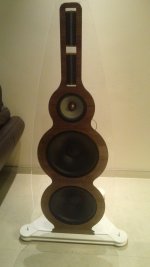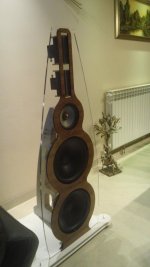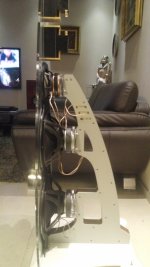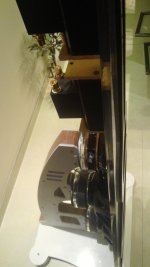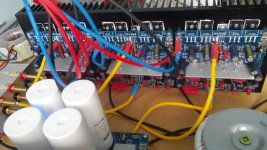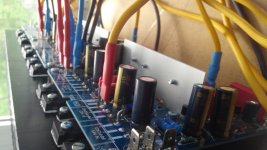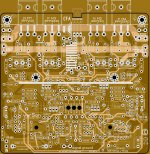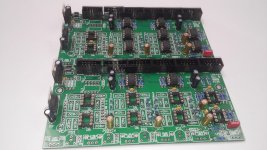After several months design and construction one loudspeaker is almost finished. Speakers used Peerless SLS 12", Seas Excel , Own Ribbon 30cm long design. Temporary 2 Ravens are used instead.
Attachments
Very nicely done. The transparent baffle is very well integrated and the excellent craftsmanship is evident throughout. Nice job. Looking forward to some measurements as you work on your design---mostly so I can learn from your efforts.
Few
Few
Very nice build! Why 2 ribbons?
//
Perhaps to improve the horizontal dispersion... which is not ideal for OB.
But who care to be totally perfect from everywhere all the time ?

A beautiful expression of the inherent nature of the cone drivers analogous to buildings that show their bones, like the Pompidou Centre.
But.... I think the way most people think about OBs is mistaken because in a room, their FR really does not suddenly "fall off a cliff" below a certain wavelength due to cancellation of phases. A textbook example might show a simple diagram of a circular baffle with a single driver in the centre and never the results of a complex shape like in this thread.
But but, you do need some bit of baffling to ensure some amount of rear wave is propagated out the back and to the rear walls, and that may be a bit more than in this beautiful speaker provides.
Ben
But.... I think the way most people think about OBs is mistaken because in a room, their FR really does not suddenly "fall off a cliff" below a certain wavelength due to cancellation of phases. A textbook example might show a simple diagram of a circular baffle with a single driver in the centre and never the results of a complex shape like in this thread.
But but, you do need some bit of baffling to ensure some amount of rear wave is propagated out the back and to the rear walls, and that may be a bit more than in this beautiful speaker provides.
Ben
Last edited:
A beautiful expression of the inherent nature of
But but, you do need some bit of baffling to ensure some amount of rear wave is propagated out the back and to the rear walls, and that may be a bit more than in this beautiful speaker provides.
Ben
And the SLS12 are a tad limited by their short excursion... but they are not designed to shake the house with 100dB... IMHO
And the SLS12 are a tad limited by their short excursion... but they are not designed to shake the house with 100dB... IMHO
I know that SLS12 are limited. I know that AE or GR are better but in Europe both are much more expensive. Maybe in any latter revision I put AE.
I know that SLS12 are limited. I know that AE or GR are better but in Europe both are much more expensive. Maybe in any latter revision I put AE.
Hello,
Which crossover are you using ?
Which amp are you using ?
Have you tested them ?
Have you tried to put a 100 dB sine wave at 80 Hz to test your baffles ?
Last edited:
Hello,
Which crossover are you using ?
Which amp are you using ?
Have you tested them ?
Have you tried to put a 100 dB sine wave at 80 Hz to test your baffles ?
Hi
in this moment I'm using Behringer DCX-2496 but also I'm building Elliot Sound product LRX424 Project125. Maybe latter all change with mini DSP or similar.
For amplifier I'm also building this project located here:
http://www.diyaudio.com/forums/solid-state/243481-200w-mosfet-cfa-amp-98.html
I have not made measurements because my own ribbon is not ready.
It is not easy to be in 3 projects in the same time. Therefore it is very slow.
Attachments
Hi
in this moment I'm using Behringer DCX-2496 but also I'm building Elliot Sound product LRX424 Project125. Maybe latter all change with mini DSP or similar.
For amplifier I'm also building this project located here:
http://www.diyaudio.com/forums/solid-state/243481-200w-mosfet-cfa-amp-98.html
I have not made measurements because my own ribbon is not ready.
It is not easy to be in 3 projects in the same time. Therefore it is very slow.
Building discrete amplifiers takes a lot of time 😀
You should try one woofer at a loud 80 Hz with a generic amplifier for testing only (if there is rattling noises)... IMHO 😉
The only improvement that I can envision is to reduce the baffle width around the midrange and tweeters to as little as possible. This will improve the off-axis response by making it very similar to the on-axis response but down a few dB.
For the woofers, there is no way you can get loud, low bass with the width of the baffle you are using if you go with a dipole configuration. You might think about a sealed box subwoofer for the lowest frequencies (e.g. below 60 or 80 Hz). This will reduce the excursion requirements for the woofers significantly, meaning you can get them to play louder within Xmax. This will reduce strain (distortion) and provide good low end from the sealed sub.
For the woofers, there is no way you can get loud, low bass with the width of the baffle you are using if you go with a dipole configuration. You might think about a sealed box subwoofer for the lowest frequencies (e.g. below 60 or 80 Hz). This will reduce the excursion requirements for the woofers significantly, meaning you can get them to play louder within Xmax. This will reduce strain (distortion) and provide good low end from the sealed sub.
I like Charlie's suggestion for adding a sub below 60Hz but I have to say you have made a real work of art. Your speakers are beautiful, worthy of an art gallery.
The only improvement that I can envision is to reduce the baffle width around the midrange and tweeters to as little as possible. This will improve the off-axis response by making it very similar to the on-axis response but down a few dB.
For the woofers, there is no way you can get loud, low bass with the width of the baffle you are using if you go with a dipole configuration. You might think about a sealed box subwoofer for the lowest frequencies (e.g. below 60 or 80 Hz). This will reduce the excursion requirements for the woofers significantly, meaning you can get them to play louder within Xmax. This will reduce strain (distortion) and provide good low end from the sealed sub.
IMHO you should not worry about SPL (but a lot more about the THD), i've got only one 18' sub without any baffling for my whole listening room and it's more than enough (thanks to room gain).
My real worry with this design is the ability of the drivers in the 60-100Hz range particulary around 80Hz... the drivers should deliver only very very few sound pressures in this range.
IMHO you should not worry about SPL (but a lot more about the THD), i've got only one 18' sub without any baffling for my whole listening room and it's more than enough (thanks to room gain).
My real worry with this design is the ability of the drivers in the 60-100Hz range particulary around 80Hz... the drivers should deliver only very very few sound pressures in this range.
A dipole sub cannot have "room gain" in the far field because it is a velocity source and cannot pressurize the room. It's more likely that you are not really in the far field because the listening distance is closer than about 2m.
A dipole sub cannot have "room gain" in the far field because it is a velocity source and cannot pressurize the room. It's more likely that you are not really in the far field because the listening distance is closer than about 2m.
You are right !
I've experiemented a lot of "prototypes" in order to have a clean and deep bass sound in my too small room... the proximity driver with a very heavy and large well controlled membrane is unbeatable to my ears.
It is also the cheapest solution 😀
I'm still doubtfully with the SLS around 80Hz... really.
Having heard the Granada open baffle speakers with twin 12 inch drivers crank out a great live performance jazz organ album, I have no doubt that our friends system here should be able to do very well in the 60-100Hz range. In fact it looks like a great system that perhaps would benefit from proper room placement (i.e. treatments for early reflections) a bit of dsp shaping and a subwoofer for the very low end. It may not be the ne plus ultra of all systems but give the guy credit for making a real work of art.
- Status
- Not open for further replies.
- Home
- Loudspeakers
- Planars & Exotics
- Another OB design
